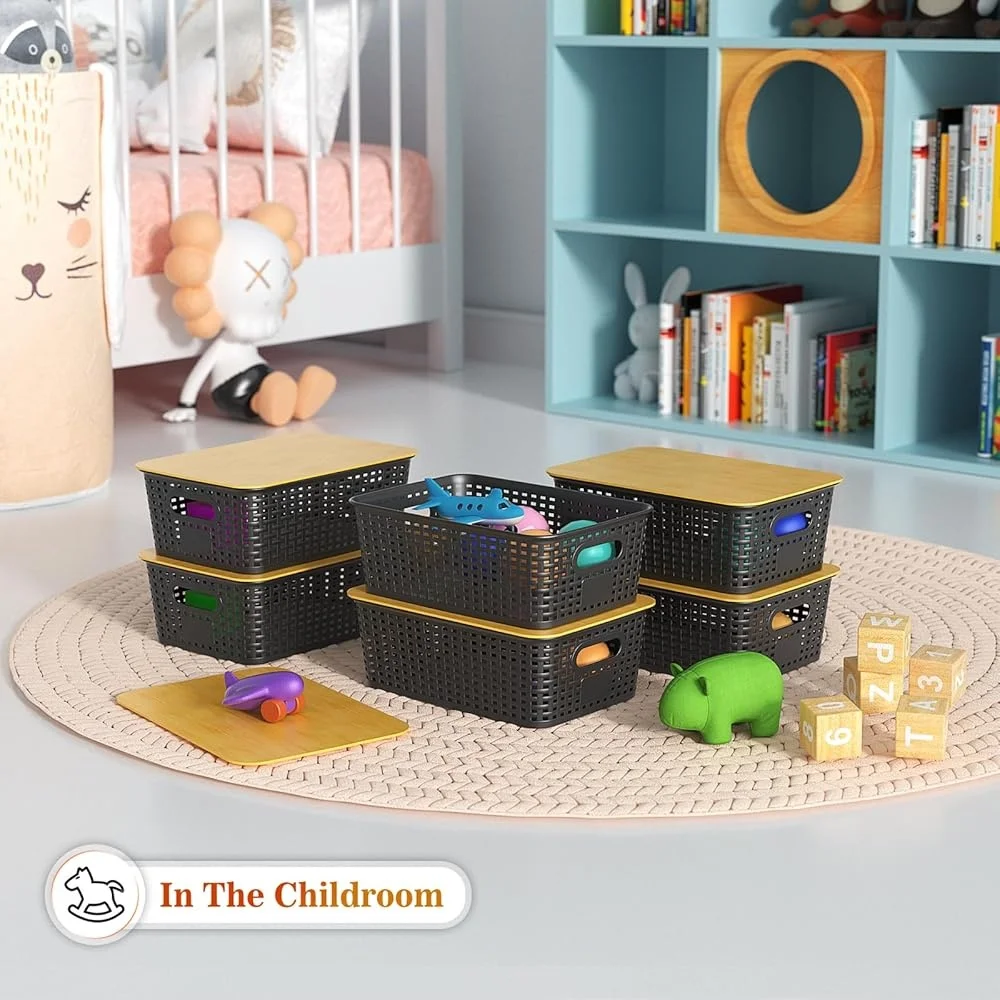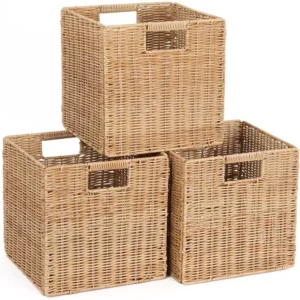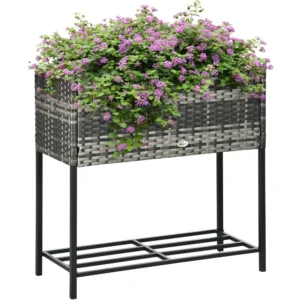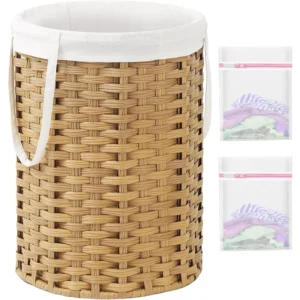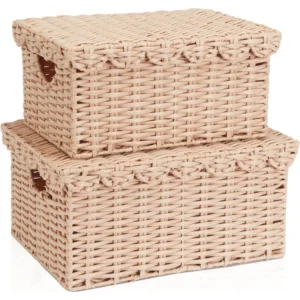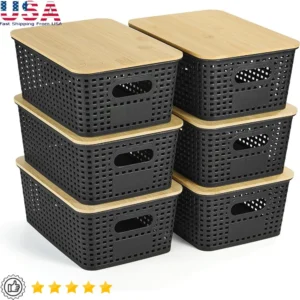Why Proper Rattan Basket Storage Matters
Rattan is a natural material with remarkable properties—flexible, durable, and visually appealing. However, its porous nature makes it particularly susceptible to environmental conditions. Without proper storage, your beautiful rattan baskets can quickly deteriorate, losing both their aesthetic appeal and functional value.
Improper storage can lead to several issues:
- Mold and mildew growth in humid conditions
- Warping and distortion when stacked incorrectly
- Brittleness and cracking in excessively dry environments
- Fading and discoloration from sun exposure
- Dust accumulation in crevices that’s difficult to remove
When you store your rattan baskets correctly, you’ll enjoy numerous benefits:
- Extended lifespan, often by many years
- Preservation of the basket’s original shape and appearance
- Maintained structural integrity and functionality
- Protection of your investment in quality home décor
Understanding how to properly organize and maintain your laundry wicker baskets and other rattan items ensures they remain beautiful and functional for years. Our collection of premium rattan storage baskets are designed to last, but even the finest quality pieces require proper care.
Essential Preparation Before Storage
Before placing your rattan baskets in storage, proper preparation is essential. This groundwork ensures your baskets remain in optimal condition throughout their time in storage.
Cleaning Your Rattan Baskets
Thorough cleaning is the critical first step before storing any rattan basket. Dirt, dust, and food particles left on baskets can attract pests and lead to mold growth during storage.
For dry cleaning methods:
– Use a soft-bristled brush to gently remove surface dust from the weave
– A microfiber cloth works well for removing dust from smooth surfaces
– Vacuum with a brush attachment on low power to reach deep between weaves
For wet cleaning of dirtier baskets:
– Wipe with a slightly damp cloth for light soil
– For stubborn dirt, mix a mild cleaning solution (1 tablespoon mild dish soap in 4 cups of warm water)
– Apply the solution with a soft cloth, being careful not to saturate the rattan
– Use an old toothbrush for hard-to-reach areas between weaves
Never soak your rattan baskets or use harsh chemical cleaners, as these can damage the natural fibers and cause warping or discoloration. For more detailed instructions, our guide on how to clean wicker baskets provides step-by-step techniques for different types of dirt and stains.
Ensuring Complete Dryness
After cleaning, thorough drying is absolutely critical before storage. Any residual moisture can lead to mold growth or fiber degradation.
Place baskets in a well-ventilated area with moderate temperature (65-75°F or 18-24°C) to air dry completely. This process may take 24-48 hours depending on humidity levels. For faster drying, use fans to increase air circulation around the baskets.
To check if baskets are completely dry, look for:
– No cool feeling when touching the surface
– No darkened areas indicating moisture
– Even coloration throughout
– No musty smell
Warning: Never use direct heat sources like hairdryers, heaters, or direct sunlight to speed up drying. Excessive heat can cause rattan fibers to become brittle and crack, while direct sunlight may cause uneven fading.
Creating the Ideal Storage Environment
The environment where you store your rattan baskets significantly impacts their longevity. Creating the right conditions is as important as the physical storage method itself.
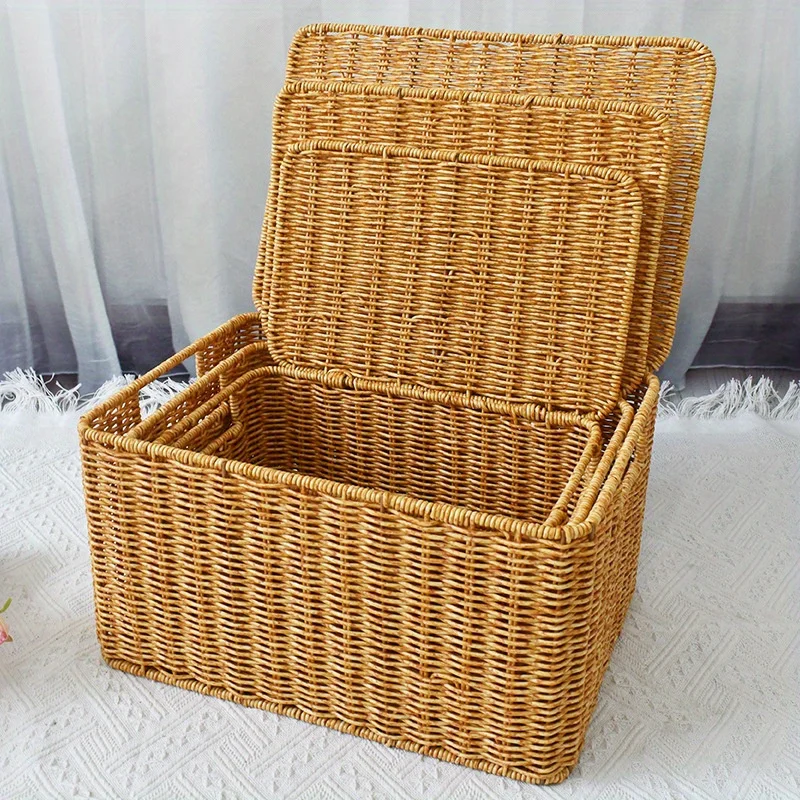
Knowing how to properly store baskets not in use will help maintain their beauty and structural integrity for years to come.
Temperature Considerations
Rattan baskets thrive in moderate, stable temperatures between 60-80°F (15-27°C). Temperature fluctuations can cause the natural fibers to expand and contract, leading to structural weakness over time.
Ideal storage locations maintain consistent temperatures year-round, such as:
– Interior closets away from exterior walls
– Main living spaces in climate-controlled homes
– Storage rooms with regulated temperatures
Avoid areas subject to seasonal temperature extremes. In winter, cold can make rattan brittle and prone to breaking. During summer, excessive heat may cause fibers to dry out and weaken.
Humidity: The Critical Factor
Humidity control is perhaps the most crucial aspect of rattan storage. The ideal relative humidity for storing rattan baskets is between 40-60%.
Optimal Humidity Range: 40-60%
Below 40%: Rattan becomes brittle, potentially leading to cracks and breaks
Above 60%: Risk of mold growth and fiber deterioration increases significantly
To monitor humidity levels, consider using an inexpensive hygrometer near your storage area. For humidity control:
– In damp environments, use dehumidifiers or silica gel packets placed near (but not touching) your baskets
– In dry environments, consider using a humidifier during winter months when indoor air tends to be drier
– Avoid basements and attics where humidity fluctuates dramatically
Light and Air Circulation
While darkness is preferred for storage, some air circulation is essential. UV light exposure causes rattan to fade and become brittle over time, so storage areas should be away from direct sunlight and ideally somewhat dark.
For optimal air circulation:
– Leave some space around baskets rather than pressing them against walls
– Consider using shelving that allows airflow underneath
– Avoid completely sealed containers that trap moisture
– Use breathable covers that block dust while allowing some air movement
The balance between ventilation and dust protection is delicate but achievable with proper planning and materials.
Best Storage Methods and Techniques
The physical arrangement of your rattan baskets during storage is as important as the environmental conditions. Proper techniques prevent warping, maintain shape, and protect against dust accumulation.
Creative wicker laundry basket storage ideas can be adapted for all types of rattan baskets, ensuring they maintain their shape and structure during storage periods.
Protective Covering Options
When choosing coverings for stored rattan baskets, breathability is key:
| Covering Material | Suitability | Breathability | Protection Level |
|---|---|---|---|
| Cotton sheets/pillowcases | Excellent | High | Good dust protection |
| Muslin cloth | Excellent | Very high | Moderate dust protection |
| Acid-free tissue | Good | High | Light protection |
| Plastic bags/containers | Poor | Very low | High protection but traps moisture |
| Vacuum-sealed bags | Very poor | None | Not recommended for rattan |
For longer-term storage, consider adding natural pest deterrents like cedar blocks or lavender sachets near (but not directly on) your baskets. These help repel insects without damaging the rattan fibers.
Never use plastic bags or airtight containers for rattan storage. While they may seem protective, they trap moisture and prevent necessary air circulation, creating perfect conditions for mold growth.
Preserving Basket Shape
To maintain the original shape of your baskets during storage:
- Stuff larger baskets with acid-free tissue paper, clean white cotton sheets, or white pillowcases to provide internal support
- For baskets with handles, ensure handles are properly supported and not bearing weight
- If nesting smaller baskets inside larger ones, place acid-free tissue between them to prevent scratching and ensure even weight distribution
- Consider hanging round baskets with sturdy handles to maintain their circular shape
- For flat-bottomed baskets, store on a flat, level surface
Avoid placing heavy items on top of stored baskets, as the weight can cause permanent deformation over time, especially in humid environments where rattan becomes more pliable.
Ideal Storage Locations: The Do’s and Don’ts
Choosing the right location for storing your rattan baskets can make all the difference in maintaining their condition over time.
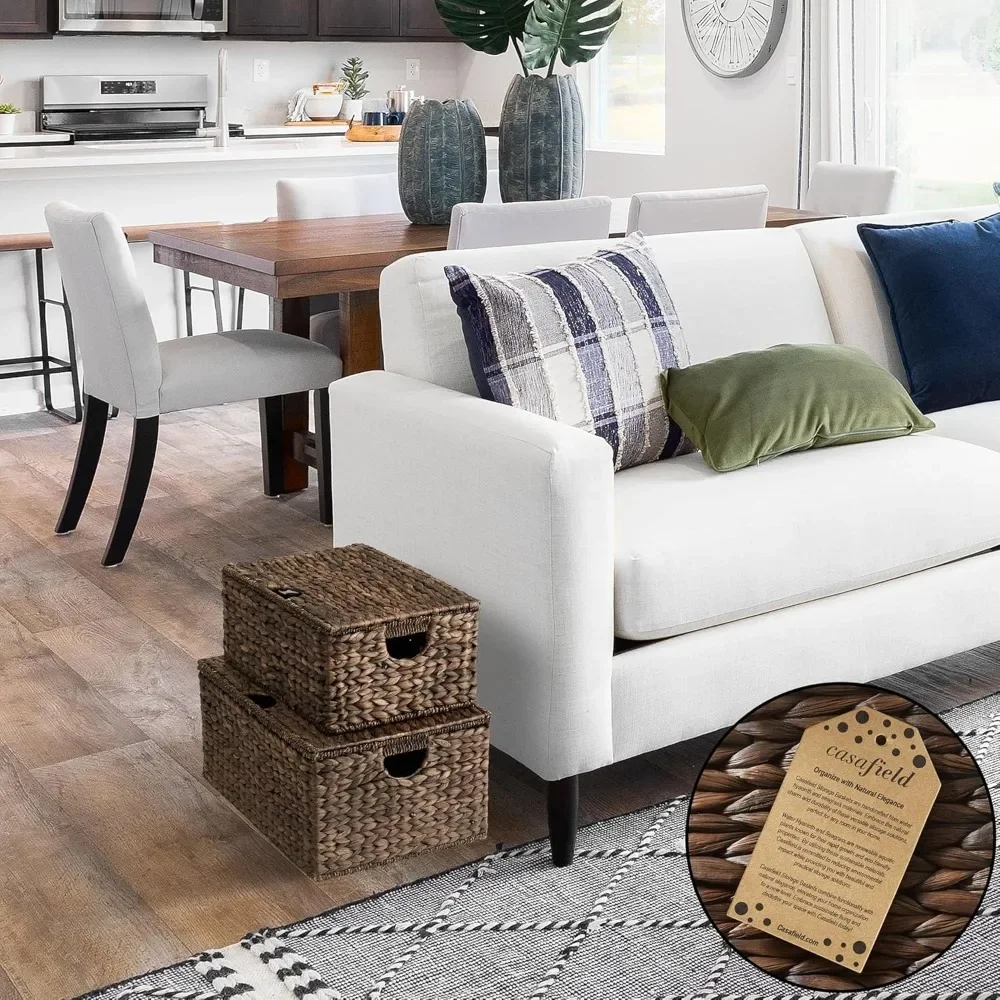
Our collection of wicker storage baskets with lids offers additional protection for items stored inside, while the baskets themselves still require proper storage conditions when not in use.
Best Places for Rattan Storage
These locations typically provide the ideal conditions for rattan basket storage:
- Interior closets: Particularly those on interior walls that maintain consistent temperatures year-round and have doors to keep out dust
- Under beds: If elevated at least 6 inches off the floor and protected with cotton dust covers, this space often maintains good temperature stability
- Dedicated storage rooms: Climate-controlled spaces with moderate humidity are excellent for long-term storage
- Spare rooms or guest rooms: These typically maintained living spaces offer good environmental conditions
If your ideal storage location is slightly too dry, placing a small bowl of water nearby (not touching the baskets) can slightly increase local humidity. Conversely, a small container of silica gel can help manage excess moisture in slightly damp areas.
Storage Areas to Avoid
Some locations pose significant risks to the integrity of your rattan baskets:
- Basements: Often too damp, leading to mold and mildew growth within just a few weeks
- Attics: Temperature extremes and poor ventilation can cause warping and brittleness
- Garages: Uninsulated spaces with fluctuating humidity and temperature are particularly damaging
- Bathrooms or laundry rooms: High humidity levels from regular water usage create perfect conditions for mold growth
- Areas with direct sunlight: UV exposure causes fading and weakening of fibers within months
Concrete floors present a special risk—they transmit moisture directly to anything stored on them. If you must use such areas, place a moisture barrier like a wooden pallet between the floor and your stored baskets.
Long-Term vs. Short-Term Storage Considerations
Your approach to rattan basket storage should vary depending on how long the items will be stored.
Black Wicker Baskets, Rattan Storage Baskets, Tall Wicker Baskets, Wicker Shelf Baskets, Woven Storage Baskets
5-Tier Distressed Black Wood Frame Storage Tower with Removable Wicker Baskets for Home Organization$715.80 Select options This product has multiple variants. The options may be chosen on the product pageRattan Shelf Baskets, Rattan Storage Baskets, Small Wicker Baskets, Square Wicker Baskets
Square Plastic Wicker Storage Baskets Set of 3 with Collapsible Design for Cube Storage Organization$185.47 Select options This product has multiple variants. The options may be chosen on the product pageRattan Shelf Baskets, Rattan Storage Baskets
$345.47 Select options This product has multiple variants. The options may be chosen on the product pageLarge Wicker Laundry Baskets, Rattan Laundry Baskets, Woven Laundry Hampers
$162.32 Select options This product has multiple variants. The options may be chosen on the product pageWicker Baskets with Lids, Wicker Storage Baskets with Lids
$192.98 Select options This product has multiple variants. The options may be chosen on the product pageWicker Storage Baskets with Lids, Woven Storage Baskets
$100.94 Select options This product has multiple variants. The options may be chosen on the product page
Implementing effortless laundry organization wicker baskets systems can help you rotate baskets in and out of storage while maintaining an organized home.
For short-term storage (less than 3 months):
– Basic dust protection with cotton covers is usually sufficient
– Regular home environments with stable conditions are generally adequate
– Simple stacking with tissue paper between baskets is acceptable
– Less concern about stuffing baskets to maintain shape
For long-term storage (more than 3 months):
– More thorough cleaning before storage is essential
– Consider applying a light coat of natural oil (like lemon oil) to prevent excessive drying
– Use comprehensive dust protection with breathable covers
– Ensure baskets are stuffed to maintain their original shape
– Place moisture absorbers nearby if in slightly humid conditions
– Check on items approximately every 3 months if possible
– Implement robust pest prevention measures
– Select storage location with extra care for environmental stability
For valuable or antique rattan pieces that require storage beyond a year, professional storage facilities with climate control might be worth the investment.
Troubleshooting Common Rattan Storage Problems
Even with the best preparation, issues can still arise during storage. Knowing how to address these problems can help salvage your rattan baskets.
If your baskets have been improperly stored and need restoration, our guide on how to restore old woven baskets provides detailed DIY techniques to bring them back to life.
Can mold on rattan baskets be removed?
Yes, if caught early enough, mold can often be successfully removed from rattan baskets:
- First, take the basket outdoors to prevent spreading mold spores in your home
- Gently brush away visible mold with a soft-bristled brush
- Create a cleaning solution of equal parts white vinegar and water
- Dip a cloth in the solution, wring until just damp, and wipe affected areas
- For stubborn mold, use a soft toothbrush dipped in the solution
- Dry thoroughly in a well-ventilated area out of direct sunlight
- Once completely dry, expose the basket to a few hours of indirect sunlight, as UV light has natural disinfectant properties
Black or deep green mold that has penetrated the fibers may cause permanent staining, even when the mold is killed. Prevention through proper storage is always preferable to remediation.
How do you restore dry or brittle rattan?
Excessively dry rattan becomes brittle and prone to breakage but can often be revitalized:
- Clean the basket thoroughly to remove dust and debris
- Create a conditioning solution of 2 parts boiled linseed oil to 1 part turpentine
- Apply a light coat to the rattan using a soft cloth, working it into the fibers
- Allow the solution to penetrate for 30 minutes, then wipe off any excess
- Place in a moderately humid environment (50-60% humidity) for 24 hours
- Apply a second light coat if the rattan still appears dry
Commercial rattan conditioning products are also available and can be effective for restoring moisture. However, severely cracked or split rattan may be beyond restoration, making proper preventative storage all the more important.
Expert Tips for Bringing Baskets Out of Storage
Transitioning your rattan baskets back into use requires careful attention to help them readjust to their new environment.
Allow for acclimatization: Before using stored baskets, let them sit in their new environment for 24-48 hours. This allows the natural fibers to adjust gradually to any differences in temperature or humidity.
Gentle cleaning: Even with proper storage, some dust may accumulate. Use a soft brush or microfiber cloth to gently remove any dust before use. Avoid harsh cleaning immediately after storage.
Refresh and deodorize: If baskets have developed a musty smell, place them outdoors in indirect sunlight for a few hours. For persistent odors, sprinkle baking soda inside, let sit overnight, then vacuum thoroughly.
Inspect thoroughly: Check for any signs of damage, loose weaving, or mold that may have developed during storage. Address any issues before putting baskets back into regular use.
Condition if needed: If baskets appear dry after storage, a light application of natural oil can help restore moisture and flexibility to the fibers.
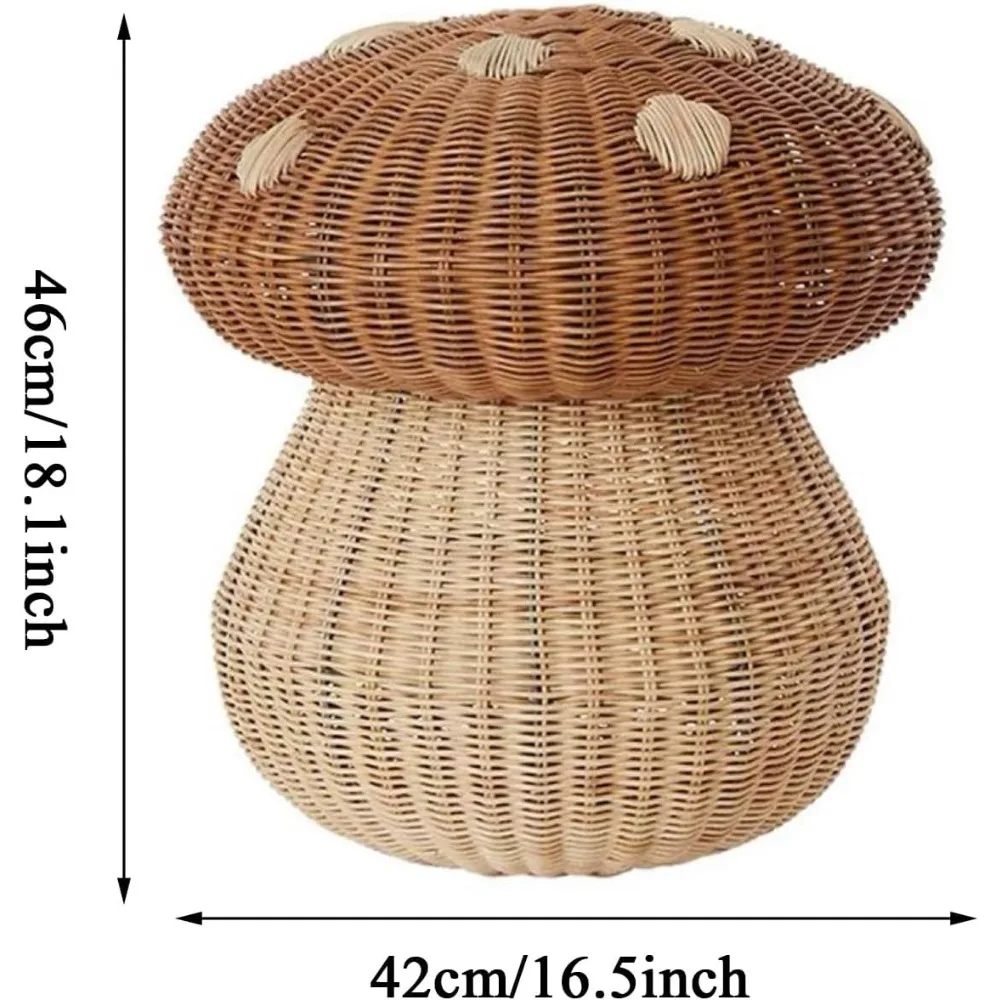
Our premium rattan baskets are designed for beauty and durability, but even the highest quality pieces benefit from proper storage practices when not in use.
FAQs About Storing Rattan Baskets
How often should stored rattan baskets be checked?
Ideally, check on stored rattan baskets every 3 months. This regular inspection allows you to catch and address any developing issues like humidity changes, pest problems, or shape distortion before they cause permanent damage.
Is it safe to store different types of rattan together?
Yes, different types of rattan baskets can generally be stored together. However, avoid placing dyed or painted rattan directly against natural rattan as color transfer can occur over time, especially in humid conditions.
Can rattan baskets be stored in plastic containers?
It’s not recommended to store rattan baskets in sealed plastic containers. While they may keep dust out, they also trap moisture and prevent necessary air circulation. If you must use plastic containers, leave the lids partially open or drill ventilation holes.
How to store decorated or painted rattan baskets?
Decorated baskets require extra care. Wrap any embellishments in acid-free tissue paper to prevent snagging or crushing. For painted baskets, avoid direct contact with other items and use acid-free paper between baskets if stacking. Keep these baskets away from high humidity, which can cause paint to soften or become sticky.
Should I apply any treatments before storing rattan baskets?
For long-term storage, a light application of lemon oil can help preserve moisture in the rattan fibers. However, this is optional for short-term storage. Understanding the differences between natural vs synthetic rattan can help determine the best treatment approach for your specific baskets.
Summary: Best Practices for Rattan Basket Storage
To ensure your beautiful rattan baskets remain in pristine condition during storage periods:
- Clean thoroughly and ensure complete dryness before storing
- Maintain stable temperature between 60-80°F (15-27°C)
- Keep relative humidity between 40-60%
- Use breathable cotton covers rather than plastic
- Stuff larger baskets with acid-free tissue to maintain shape
- Store in interior closets or other climate-controlled spaces
- Avoid basements, attics, and areas with direct sunlight
- Inspect stored baskets every 3 months when possible
- Allow baskets to acclimate when bringing them out of storage
Following these guidelines will help preserve your rattan baskets’ beauty and structural integrity, ensuring they remain both functional and decorative for many years. At Tidy Treasure, we believe quality rattan pieces are investments in your home’s aesthetics and organization—investments worth protecting through proper storage techniques.

